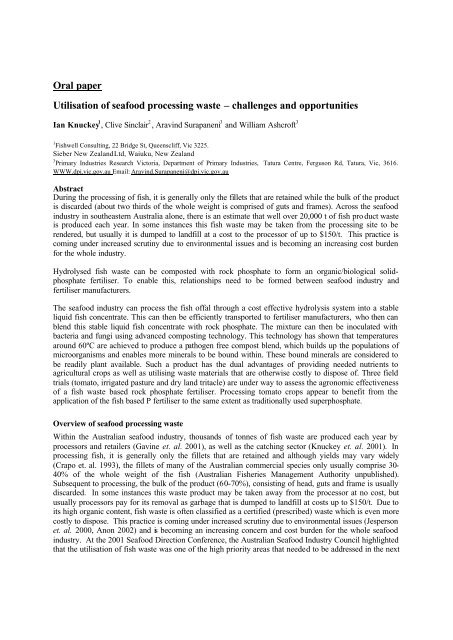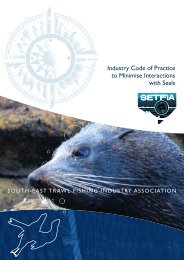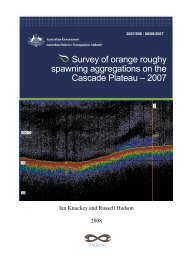Utilisation of seafood processing waste - Fishwell Consulting
Utilisation of seafood processing waste - Fishwell Consulting
Utilisation of seafood processing waste - Fishwell Consulting
You also want an ePaper? Increase the reach of your titles
YUMPU automatically turns print PDFs into web optimized ePapers that Google loves.
Oral paper<br />
<strong>Utilisation</strong> <strong>of</strong> <strong>seafood</strong> <strong>processing</strong> <strong>waste</strong> – challenges and opportunities<br />
Ian Knuckey 1 , Clive Sinclair 2 , Aravind Surapaneni 3 and William Ashcr<strong>of</strong>t 3<br />
1 <strong>Fishwell</strong> <strong>Consulting</strong>, 22 Bridge St, Queenscliff, Vic 3225.<br />
Sieber New Zealand Ltd, Waiuku, New Zealand<br />
3 Primary Industries Research Victoria, Department <strong>of</strong> Primary Industries, Tatura Centre, Ferguson Rd, Tatura, Vic, 3616.<br />
WWW.dpi.vic.gov.au Email: Aravind.Surapaneni@dpi.vic.gov.au<br />
Abstract<br />
During the <strong>processing</strong> <strong>of</strong> fish, it is generally only the fillets that are retained while the bulk <strong>of</strong> the product<br />
is discarded (about two thirds <strong>of</strong> the whole weight is comprised <strong>of</strong> guts and frames). Across the <strong>seafood</strong><br />
industry in southeastern Australia alone, there is an estimate that well over 20,000 t <strong>of</strong> fish pro duct <strong>waste</strong><br />
is produced each year. In some instances this fish <strong>waste</strong> may be taken from the <strong>processing</strong> site to be<br />
rendered, but usually it is dumped to landfill at a cost to the processor <strong>of</strong> up to $150/t. This practice is<br />
coming under increased scrutiny due to environmental issues and is becoming an increasing cost burden<br />
for the whole industry.<br />
Hydrolysed fish <strong>waste</strong> can be composted with rock phosphate to form an organic/biological solidphosphate<br />
fertiliser. To enable this, relationships need to be formed between <strong>seafood</strong> industry and<br />
fertiliser manufacturers.<br />
The <strong>seafood</strong> industry can process the fish <strong>of</strong>fal through a cost effective hydrolysis system into a stable<br />
liquid fish concentrate. This can then be efficiently transported to fertiliser manufacturers, who then can<br />
blend this stable liquid fish concentrate with rock phosphate. The mixture can then be inoculated with<br />
bacteria and fungi using advanced composting technology. This technology has shown that temperatures<br />
around 60ºC are achieved to produce a pathogen free compost blend, which builds up the populations <strong>of</strong><br />
microorganisms and enables more minerals to be bound within. These bound minerals are considered to<br />
be readily plant available. Such a product has the dual advantages <strong>of</strong> providing needed nutrients to<br />
agricultural crops as well as utilising <strong>waste</strong> materials that are otherwise costly to dispose <strong>of</strong>. Three field<br />
trials (tomato, irrigated pasture and dry land tritacle) are under way to assess the agronomic effectiveness<br />
<strong>of</strong> a fish <strong>waste</strong> based rock phosphate fertiliser. Processing tomato crops appear to benefit from the<br />
application <strong>of</strong> the fish based P fertiliser to the same extent as traditionally used superphosphate.<br />
Overview <strong>of</strong> <strong>seafood</strong> <strong>processing</strong> <strong>waste</strong><br />
Within the Australian <strong>seafood</strong> industry, thousands <strong>of</strong> tonnes <strong>of</strong> fish <strong>waste</strong> are produced each year by<br />
processors and retailers (Gavine et. al. 2001), as well as the catching sector (Knuckey et. al. 2001). In<br />
<strong>processing</strong> fish, it is generally only the fillets that are retained and although yields may vary widely<br />
(Crapo et. al. 1993), the fillets <strong>of</strong> many <strong>of</strong> the Australian commercial species only usually comprise 30-<br />
40% <strong>of</strong> the whole weight <strong>of</strong> the fish (Australian Fisheries Management Authority unpublished).<br />
Subsequent to <strong>processing</strong>, the bulk <strong>of</strong> the product (60-70%), consisting <strong>of</strong> head, guts and frame is usually<br />
discarded. In some instances this <strong>waste</strong> product may be taken away from the processor at no cost, but<br />
usually processors pay for its removal as garbage that is dumped to landfill at costs up to $150/t. Due to<br />
its high organic content, fish <strong>waste</strong> is <strong>of</strong>ten classified as a certified (prescribed) <strong>waste</strong> which is even more<br />
costly to dispose. This practice is coming under increased scrutiny due to environmental issues (Jesperson<br />
et. al. 2000, Anon 2002) and is becoming an increasing concern and cost burden for the whole <strong>seafood</strong><br />
industry. At the 2001 Seafood Direction Conference, the Australian Seafood Industry Council highlighted<br />
that the utilisation <strong>of</strong> fish <strong>waste</strong> was one <strong>of</strong> the high priority areas that needed to be addressed in the next
two years. In south eastern Australia alone, there are estimates that well over 20,000 t <strong>of</strong> fish product<br />
<strong>waste</strong> is produced by the <strong>seafood</strong> industry each year (Knuckey 2004).<br />
With most <strong>of</strong> Australia’s fish stocks near or at full exploitation, it is unlikely that the <strong>seafood</strong> industry will<br />
expand and develop through increased wild-capture harvests. One <strong>of</strong> the main options for increased pr<strong>of</strong>its<br />
to the <strong>seafood</strong> industry is through value-adding the current catch. The Fisheries Research and<br />
Development Corporation (FRDC) set up the South East Fishery Industry Development Subprogram to<br />
specifically explore such options. The main focus <strong>of</strong> this Subprogram over the last two years has been to<br />
find a solution to the large amounts <strong>of</strong> fish <strong>waste</strong> that are discarded by the <strong>seafood</strong> industry each year.<br />
Options for utilisation <strong>of</strong> <strong>seafood</strong> <strong>processing</strong> <strong>waste</strong><br />
At a FRDC workshop in 2001, <strong>seafood</strong> industry leaders discussed ways to improve the utilisation <strong>of</strong> fish<br />
<strong>waste</strong> by investigating techniques to process the <strong>waste</strong> into products such as aquaculture feeds, silage,<br />
fertilisers, fish mince, and fishmeal. After considering a variety <strong>of</strong> options, it was agreed that <strong>processing</strong><br />
the <strong>waste</strong> into valuable fertiliser products was the option that was most feasible at that point in time. This<br />
option suited the particular characteristics <strong>of</strong> the processors and the raw product that they produce: it could<br />
utilise the bulk <strong>of</strong> the fish <strong>waste</strong> and prove cost-effective given the relatively low volume and wide<br />
geographical area covered by Australia's <strong>seafood</strong> industry. It was acknowledged that if the utilisation <strong>of</strong><br />
fish <strong>waste</strong> were to be successful on a broad scale, it would require a considerable level <strong>of</strong> coordination and<br />
cooperation, both within the <strong>seafood</strong> industry supply chain and across a range <strong>of</strong> different areas. It would<br />
also require the sensible use <strong>of</strong> the current resources and investment into infrastructure <strong>of</strong> the <strong>seafood</strong><br />
industry towards <strong>waste</strong> utilisation.<br />
To achieve the above, the Subprogram formed Australian Seafood Co-products (ASCo) during 2002. The<br />
goal <strong>of</strong> ASCo is to add value to the <strong>seafood</strong> supply chain through the sustainable utilisation <strong>of</strong> fish and<br />
fish co-products that are not traditionally utilised or marketed. ASCo shareholders include the FRDC and<br />
numerous major Australian <strong>seafood</strong> companies from Queensland, New South Wales, Victoria, Tasmania<br />
and South Australia. Their initial shareholder contributions have been used alongside Federal government<br />
funding to run a number <strong>of</strong> projects to help get ASCo <strong>of</strong>f the ground. Some <strong>of</strong> the projects that have been<br />
completed to date include a feasibility study on installation <strong>of</strong> a fish silage plant at central fish <strong>processing</strong><br />
sites, development <strong>of</strong> a business network plan for ASCo and development <strong>of</strong> an agreed structure for the<br />
operation <strong>of</strong> ASCo. Although it considered a number <strong>of</strong> uses for fish <strong>waste</strong>, ASCo decided that<br />
<strong>processing</strong> <strong>of</strong> the fish <strong>waste</strong> into a valuable organic fertiliser was the option that was most feasible at this<br />
point in time. As a consequence, ASCo Fertilisers was formed – a partnership between ASCo and Sieber,<br />
a New Zealand company that has the proven technology and experience to process fish <strong>waste</strong>s into<br />
fertilisers. Through this partnership, ASCo Fertilisers intends to utilise large quantities <strong>of</strong> fish <strong>waste</strong> from<br />
across south-eastern Australia to produce fish-based fertiliser products that can be potentially used by the<br />
farming sector for agricultural crops and can be certified for use in the rapidly growing organic (farming)<br />
market. Any research in this area will be an exciting proposition given it is a potential win for the <strong>seafood</strong><br />
industry, the agriculture industry and the environment.<br />
Fish nutrient<br />
Fish nutrient is an inert liquid produced by enzymatic hydrolysis. It is manufactured by grinding whole<br />
fish or fish <strong>waste</strong>, which is then transferred to a tank or vat where an acid is added, and the whole mixture<br />
agitated until the enzymatic hydrolysis process is complete. A variety <strong>of</strong> acids are suitable, but in this case<br />
concentrated sulphuric acid (H 2 SO 4 ) is used, as it is readily available, relatively easily handled,<br />
inexpensive and the sulphur (S) content is beneficial to the crop. The H 2 SO 4 added (2% by weight), helps<br />
initiate hydrolysis <strong>of</strong> the fish, but its primary purpose is to reduce the pH to prevent microbial spoilage.<br />
The hydrolysis process proceeds as the endogenous enzymes in the fish are released from the cells and<br />
digest the fish tissue. This process is controlled by temperature and is preferably carried out in an<br />
insulated and jacketed tank. As this process is exothermic (heat producing), the insulation enables heat to
e retained, which accelerates the process. The water jacket enables heating <strong>of</strong> the tank if required to keep<br />
the temperature to desired levels. A temperature <strong>of</strong> 30ºC provides rapid breakdown <strong>of</strong> the fish, but higher<br />
or lower temperatures will provide good results without degradation <strong>of</strong> the product. Temperatures higher<br />
than 50ºC should normally be avoided to prevent destruction <strong>of</strong> the enzymes which drive the process, or<br />
degradation <strong>of</strong> the amino acids in the fish nutrient.<br />
Careful control <strong>of</strong> the pH is essential to avoid bacterial spoilage. This is usually achieved by use <strong>of</strong> an<br />
automatic pH meter and acid dosing pump, which will maintain the process at a pH <strong>of</strong> 3.0-3.5.<br />
Depending on the temperature, the hydrolysis process is usually complete after 48 hours. The liquid fish<br />
nutrient is then passed through a 1 mm screen to remove any solid material. From a batch <strong>of</strong> 10 tonnes <strong>of</strong><br />
fish byproduct there is usually only about 50 kg <strong>of</strong> solid <strong>waste</strong> (more than 1 mm in size).<br />
Fish nutrient can be stored indefinitely in agitated steel or some plastic containers without spoilage, if the<br />
pH is at the correct level.<br />
Biologically activated rock phosphate fertiliser<br />
There are numerous naturally occurring soil microorganisms that are capable <strong>of</strong> extracting the phosphorus<br />
(P) from soil or minerals including phosphate rock, (Agnihotri et. al. 1970) and making it available to<br />
plants (Mclaren et. al.1990) . However, when phosphate rock is added to the soil, this process usually<br />
proceeds very slowly.<br />
Addition <strong>of</strong> biological material, such as fish nutrient, and inoculation with bacteria and fungi will result in<br />
acceleration <strong>of</strong> the biological breakdown <strong>of</strong> rock phosphate (During et. al.1984). The bacteria and fungi<br />
feed on the fish nutrient and produce acids (Mckenzie et. al. 1995), which in turn break down the rock<br />
phosphate into more biologically available forms. This process can occur in the soil but is realitively slow<br />
when compared with its application in a factory environment which results in a biologically activated<br />
phosphate fertiliser (Chitralekha et. al.).<br />
The Sieber group (now known as Kagree Holdings Limited) has previously manufactured biologically<br />
activated phosphate fertiliser using 5% by weight <strong>of</strong> fish nutrient in a composting process. However, this<br />
process was typically partly anaerobic, which at times resulted in <strong>of</strong>f-odours and had the potential to<br />
produce pathogenic bacteria. One particular problem that has been experienced in commercial production<br />
<strong>of</strong> biologically activated phosphate fertiliser in the past was contamination by Clostridium perfringens, a<br />
spore-forming anaerobe (widespread in the soil), some strains <strong>of</strong> which can cause enterotoxaemia and<br />
"pulpy kidney" in sheep. These problems have been overcome by development <strong>of</strong> a controlled aerobic low<br />
moisture (
digested, leaving voids in the mixture. The organic timber also is able to “fix” free ranging elements<br />
including nitrogen.<br />
The mixture is then held in a (preferably insulated) concrete bin, where air is forced through from the<br />
bottom <strong>of</strong> the bin to ensure the aerobic process is maintained. It is important to maintain moisture content<br />
below 10%, to avoid development <strong>of</strong> anaerobic zones and avoid loss <strong>of</strong> valuable nitrogen (as ammonia).<br />
Proliferation <strong>of</strong> bacteria in the early stage <strong>of</strong> the process will result in the mixture reaching temperatures <strong>of</strong><br />
around 60ºC, which can be maintained for several days. The temperature then gradually decreases, during<br />
which phase there is a proliferation <strong>of</strong> fungal mycelia through the phosphate mass. These fungi partially<br />
absorb phosphate released during production.<br />
The end product from this process comprises a free -flowing powdery or sandy material with 5% to 10%<br />
moisture content, containing a variety <strong>of</strong> dead or living micro-organisms and some secretions, at a pH <strong>of</strong><br />
about 7 to 7.2 (sometimes pH 6.5 to 7.5, depending on the rock phosphate used). The microorganisms<br />
have already begun to solubilise or digest the phosphate rock while being supported by a community <strong>of</strong><br />
other microorganisms that are converting the nutrients into cellular material.<br />
Depending on the source <strong>of</strong> rock phosphate the analysis is high (Table 1) due to the relatively low (10%<br />
by weight) addition <strong>of</strong> composting ingredients. The end product can be handled through conventional<br />
fertiliser storage and distribution facilities and is applied to farms using conventional spreading methods.<br />
The Biologically activated rock phosphate fertiliser (BioPhos in short) is currently marketed to farmers in<br />
New Zealand who are looking to establish a biological mineral delivery system (enzymic phosphate)<br />
through the soil to the plant. The product has organic certification in New Zealand Biogro # 0171.<br />
Table 1 Typical analysis <strong>of</strong> biologically activated rock phosphate (Ben Guerir) fertiliser<br />
Analyte Typical fish <strong>waste</strong> based rock<br />
phosphate fertilizer<br />
Total P (%) 12.5<br />
P as water soluble<br />
n/a<br />
P as citric soluble (%) 3.85<br />
Converted to total product (%) 30.7<br />
Total K<br />
Nil<br />
Total S (%) 0.71<br />
Total Ca (%) 38.3<br />
Total N (%) Up to 3<br />
Organic matter (loss on ignition at 550 0 C) 5<br />
Agricultural trials<br />
The <strong>seafood</strong> industry in south eastern Australia is currently developing BioPhos fertiliser in Australia.<br />
This has the potential to reduce environmental impact by utilising problem <strong>waste</strong>s and could also generate<br />
significant financial returns to the <strong>seafood</strong> industry. The farming sector would also gain an alternative P<br />
fertilizer.<br />
Australian soils are generally deficient in phosphorus (P) in their native state. They require the application<br />
<strong>of</strong> P fertilisers to satisfy the crop and pasture requirements for P. Two-year field trials were established at<br />
Tatura (northern Victoria) and Dutson Downs (Gippsland) to examine the effectiveness <strong>of</strong> BioPhos in<br />
comparison with traditional P fertiliser (Superphosphate) on <strong>processing</strong> tomatoes (Tatura), irrigated<br />
pasture (Tatura) and dryland tritacle (Dutson Downs). Results from two-year tomato trail will be presented<br />
here.
Tomato trial<br />
Materials and methods<br />
The experiment comprised 3 treatments. These were an unfertilized control (T1), superphosphate (T2) and<br />
fish based P fertilizer product (BioPhos) (T3), replicated 12 times (3x12=36 raised beds) over 4 blocks.<br />
Each block comprised 9 raised beds 1.5 m wide x 72 m long. Experimental plots were 8 m long and 3 beds<br />
wide with all measurements taken from the central bed. Tomatoes were grown on these beds for 2<br />
consecutive seasons (2002-03 and 2003-04). P was surface applied each year (hand spread and raked into<br />
the top 10 cm <strong>of</strong> soil) at the recommended rate (120 kg P/ha) before seedling were transplanted. Table 2<br />
shows the analyses <strong>of</strong> P fertilizers applied.<br />
Table 2 Fertilizer analyses (w/w)<br />
Analyte Superphosphate (T2) Fish based P fertilizer (T3)<br />
Total P 7.52% 9.6%<br />
P as water soluble 6.84%
The data during the second season was analysed with no ‘outlying’ values as missing (Table 4). Average<br />
plant P levels at the crop establishment stage were highest for T2 and lowest for T1, similar to first season.<br />
However, early fruit stage leaf samples and fruit samples at harvest showed no significant differences<br />
between the treatments. There was no relationship between total leaf P (at all sampling dates) and total<br />
yield. There was a significant effect <strong>of</strong> treatment on total yield (p
Mclaren, R. G., & Cameron, K. C. (1993). Siol Science: an introduction to the properties and<br />
management <strong>of</strong> New Zealand soils. Oxford University Press, Auckland New Zealand.<br />
Acknowledgments<br />
We acknowledge the Fisheries Research and Development Corporation (FRDC) and DPI through the Ecologically<br />
Sustainable Agricultural Initiative (ESAI) for their financial support. We also acknowledge Bruce Green and<br />
Victoria’s Department <strong>of</strong> Innovation, Industry and Regional Development, NSW EPA’s Pr<strong>of</strong>iting from Cleaner<br />
Production Industry Partnership Program, David Gregory from the National Food Industry Strategy. Special thanks<br />
to Gordon Pender for undertaking the plant feasibility project and Wayne Street <strong>of</strong> Street Ryan and Associates for all<br />
<strong>of</strong> the work and support he has provided for the initiation <strong>of</strong> ASCo. Thanks also to Ted Loveday and Jayne<br />
Gallagher from Seafood Services Australia, Terry Moran and Steve Buckless from SETFIA, John Roach and<br />
Michael Kitchener from Master Fish Merchants Association, Grahame Turk from the Sydney Fish Market, Malcolm<br />
McLaughlin from Consolfish, and Peter Dundas-Smith and John Wilson from the Fisheries Research and<br />
Development Corporation.




